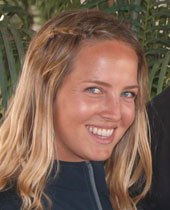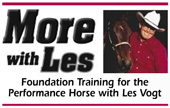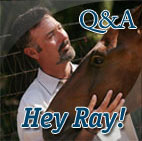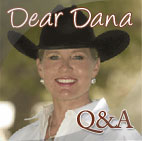A Rich Family Tradition
After more than 50 years, horses and passion drive Green Arces Ranch through 3 generations
 TEMECULA – Like so many stories, it all began with a horse.
TEMECULA – Like so many stories, it all began with a horse.
It was 1956, and a Whittier pediatrician sought the right horse to accompany his new venture, a 120-acre gentleman’s alfalfa farm in Indio. He did his homework and acquired a pair of Crabbet Arabian mares from none other than Herbert H. Reese, who ran the horse unit at Cal Poly Pomona at the time and who took the pediatrician, Dr. Harold West, under his wing and into the horse world.
“That’s how it started,” says Margaret Rich, Dr. West’s then-7-year-old daughter whose passion for horses hasn’t waned a bit at age 60.
Study: Alfalfa hay may help cure high-performance horses’ ulcers
COLLEGE STATION, Texas — Turning out a horse to pasture is commonly preferred to confinement, but research at Texas A&M University suggests that if grass is the only hay they are fed, horses can still get gastric ulcers.
According the the study, feeding alfalfa to horses that have the potential to be high performers either prevented or was therapeutic in treating stomach ulcers.
HITS Show Time! Exhibitors flock to the 2010 Desert Circuit

Ashlee Bond, top '09 GP rider
“We are thrilled to return to the desert for another year,” said HITS President and CEO Tom Struzzieri. “This is the 19th year of the HITS Desert Circuit and we are extremely proud of the product that we offer our exhibitors. Entries continue to grow from last year and that is exciting news for the sport.”
The circuit will host 16 Qualifying Grand Prix classes for the historic Pfizer $1 Million Grand Prix, which will take place Sept. 12 in Saugerties, N.Y. In addition, HITS Thermal also offers four FEI World Cup Qualifiers during weeks II, III, IV and V, which has been attracting lots of interest from international riders from Mexico and beyond. For the finale, HITS Thermal will close out the season with a monstrous $300,000 Grand Prix of the Desert, presented by Pfizer Animal Health on Sunday, March 14.
Reining in 2010 at CRHA Winter Classic
Exhibitors start the show season at L.A. Equestrian Center
Good start to the show season
The CRHA Winter Madness show came earlier this year, since it was previously held in February or March. Many exhibitors and show officials said they benefited from the schedule change.
Riding skills: Sitting In The Saddle
 To be effective with your leg cues, you need to be straddling your horse with your weight resting on the bottom of your hip bones. You also want to get to where you can stay balanced in the saddle no matter where your leg is on the horse. As we’ll discuss later, you’re going to need to move your lower leg from the spot just behind the horse’s elbow, to move his shoulder, to a position way back on his barrel, the cue to move his hip. So if you feel like you need to use your legs or the stirrups on a regular basis for balance, you’ve got a long way to go before you have the freedom to use them to effectively cue your horse. Keep just enough weight in your stirrups to keep from losing them.
To be effective with your leg cues, you need to be straddling your horse with your weight resting on the bottom of your hip bones. You also want to get to where you can stay balanced in the saddle no matter where your leg is on the horse. As we’ll discuss later, you’re going to need to move your lower leg from the spot just behind the horse’s elbow, to move his shoulder, to a position way back on his barrel, the cue to move his hip. So if you feel like you need to use your legs or the stirrups on a regular basis for balance, you’ve got a long way to go before you have the freedom to use them to effectively cue your horse. Keep just enough weight in your stirrups to keep from losing them.
A playful exercise for separation anxiety
HEY RAY!: I work with horses for a living at a major Southern California tourist attraction, but I have a problem with my own 16-year-old Quarter Horse at home. He gets extremely anxious when I take any of our other horses off of our property. He runs around, bucks, kicks out and screams so loud you can hear him a block away. How can I help him get over this before he hurts himself?
–Laura Hutchison, Corona, Calif.
HEY LAURA: Don’t feel badly — this is more common than you know. Horses act that way for many reasons. Let’s be sure we don’t “over-analyze” why your horse would act this way. We need to (1) recognize that we don’t see value in the behavior, and (2) hope that your horse recognizes his behavior is not going to get him the results he is after. Once he realizes that, he will abandon those actions and reevaluate his situation.
Remember, all your horse is trying to do here is express himself. The way we are going to help him understand his efforts are a waste of time and energy is by doing the following:
First, we have to make sure his stall or pen is tall enough and free of any unsafe obstacles. Next, we will set up a scenario where a helper will take out one of the horses from the barn and off the property. Make sure that you have communication with them so that you can ask them to come back, if needed. When your horse begins his tantrum, simply come out from a nearby place where the horse couldn’t see you and act as if the horse is calling you to interact with him. It’s key that you are not in plain sight (i.e., around the corner, behind the barn, etc.) When you do come out, simply kiss the horse off while using a long rope that you can throw and retrieve in order to keep the horse moving around the stall assertively. You want the horse to think that — by screaming and carrying on — he is calling you out to run and play. Move him around until he stops the screaming and bucking, and then back off to let him settle. Don’t stop this exercise until he looks like he’s ready to settle, then quietly retreat to your hiding spot, giving the impression that you are gone.
Soon, he’ll act up again. When he does, like a siren from a firetruck, begin to start kissing loudly the moment you hear him carry on. This will let him know you are on your way to play. Continue kissing all the way up to the stall and through the running around in the pen. Again, when he looks focused on what he’s doing, say “good boy” and return to your hiding place.
By now, the horse will wonder whether you are just around the corner or totally gone. Because this process might take a while, it’s not a bad idea to have a bale of hay or chair to sit on and maybe a good book. What we are trying to do is like what our teacher used to do on test day. After handing out the test, she would go out the door for a few seconds, then come back in. The reason was to keep the cheaters honest. Once the students believed that the teacher might still be standing behind the door, the teacher was free to leave for as long as she wanted. You need to continue this process until the horse believes that you are just around the corner.
Secondly, if and when he begins to scream, you need to be able to silence him by simply kissing loudly from your hiding place. Then and only then will you know that your horse has had the breakthrough you were hoping for. This will be a good time to bring back his buddy and reunite them.
I have used this system repeatedly with great success not only for horses like yours, but with stallions stabling next to each other, and for other undesirable behaviors.
What’s nice about this approach is that the horse is not being punished for his behavior. It’s merely a misunderstanding on our part with good intentions. The horse is calling for his buddy, but we think he’s calling us out to play. Once again, the horse will reevaluate his choices while maintaining our relationship. This should be a fun experience for you, Laura, because you will have created a scenario where your horse will never feel alone again. So, always trust your instincts and think safe,
Ray
Horsetrader columnist Ray Ariss, husband to Pippa Ariss and father of six, shares his insight into the relationship of horseand human twice each month, in print and on www.horsetrader.com. He lives and trains in “Horsetown USA”, Norco, Calif., at his bustling Starbrite Riding Academy, where he currently has 50 horses in various stages of training, including Andalusians, Friesians, Quarter Horses, Paints, Thoroughbreds, Arabs, Mustangs and more. Ray attributes his training success to the support of his wife and partner, Pippa, and a system he calls S.W.A.P., to which he credits his multiple championships in several disciplines. His passionate understanding of the “human-horse” relationship was evident when he took on the challenge of training a wild Mustang and — in just 100 days — produced the highest-priced adopted Mustang ever — $50,000. Does your “horse-human relationship” leave you with a question for Ray? Click here to submit one!
Dear Dana: Should I share my retired reiner with my granddaughter taking English lessons?
Meet Dana at Equine Affaire! Saturday, Feb. 6 at Noon in the Horsetrader booth #748
DEAR DANA: I have a grandmother’s dilemma — I am thinking of sharing my retired reiner with my 7-yr-old granddaughter, who has been taking English lessons. What problems could arise from this?
–Carolyn Read, San Marcos, Calif.
DEAR CAROLYN: My first thought is that the problem you may encounter is that she will probably fall in love with reining! I can speak from personal experience because I have two daughters who both have ridden many different events. I think it made them better riders.
My older daughter rode English and jumped at the age of your granddaughter before she started showing in the reining at the age of 8. (She placed in the Top 10 at the Quarter Horse Congress at that age.) She also showed in Western Pleasure, Trail and Horsemanship. What I had to teach her was to adjust her seat and riding for each style. I realize English style of riding is different from western, but what I would do is (1) identify the different styles of riding for her and (2) give her key words to help her to switch from one to the other.
For example, what I would say to Brook is “OK, Brook, use your pleasure seat” or “Brook switch to your English seat or your horsemanship seat”. In her young mind, it helped her to have identifying names for her body position. My younger daughter, Bree, has ridden primarily reining and western pleasure.
I had a problem for awhile in that she would push her western pleasure horse forward with her seat. I would have to tell her to soften in her seat and slow down her rhythm.
Horses truly do respond to the feel of the rider’s seat. Traditionally, an English seat is a more “forward seat” than a western seat. I teach my riders to sit a western pleasure horse differently than a reining horse, but I can tell you from experience that you can teach your granddaughter to reposition herself and her motion through her seat to fit each style of riding.
I also recommend you talk to her English instructor — she should be able to help with pointers and key words for your granddaughter. I would be glad to help also!
I hope that helps. Good Luck to you!
Dana
Have your own question for Dana? If so, click here! If your question is used in “Dear Dana”, you will be entered into a monthly drawing for a FREE “Winning Strides” DVD!
Sign up for Dana’s newsletter and keep up with Dana’s updates, new products and clinic schedule! When you register, you are automatically entered into a quarterly raffle for great prizes, including a FREE personal training session with Dana! Click here to sign up now!




 Read Columns
Read Columns

